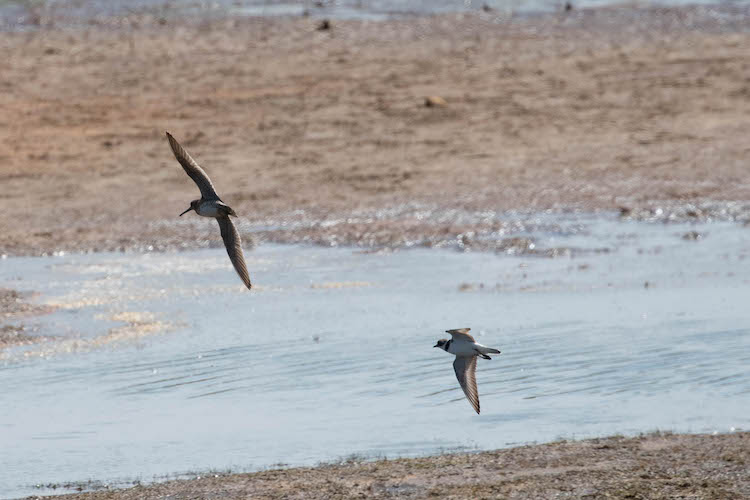Wednesday Morning Birding this week was a bit slow, so thank goodness for two facts: 1. Least Bitterns are still being easily observed from the dike at Hellcat.
2. One never tires of watching Least Bitterns skulk around, appearing and disappearing in the reeds. Sometimes a Least Bittern’s ability to suddenly blend into invisibility truly gives the impression of a “magic trick.” Why are they so much more apt to do that than say, a Green Heron? The difference is in subtleties of movement, postures and pattern, and maybe something else, some je ne sais quoi. But we enjoyed that literally elusive quality, and we can do so again and again. Have you rewatched episodes of Seinfeld, gone again to hear a favorite musical performance, gazed at your children – again? Watching Least Bitterns bears such repetition.


We had a similar but distinct experience with the Tree Swallows. At times the swirling horde we saw Wednesday came and went from the Phragmites stand in North Pool to the pines and deciduous glades near the Hellcat Parking lot and Bill Forward Blind. At the peak of the show, we saw about ten thousand birds circling the pines near us, and clots of them delighted us closer by. When we see this spectacle, something happens to your brain. Medical-ish websites list activities that produce endorphins, a class of chemicals that we produce/store in our pituitary gland and other sites. Endorphins block pain and produce euphoria. Those websites should include repeated observation of hundreds but especially thousands of Tree Swallows in their list of endorphin boosting activities. Sometimes just remembering that sight will do the trick.

Our outing this week happened when the Plum Island South tide level was at 3.3 feet and dropping. That is where the lowest third of the tidal range begins, so the shorebirds were steadily disappearing from the flats around the Main Panne and Bill Forward Pool, which are high tide roosts for migrants. I would really like to know what the surface area of high tide roosts is over the Great Marsh, and how those areas vary in foraging potential. Anybody need a PhD topic? The south end of Bill Forward Pool has been an area for both roosting and foraging for may years, because of the active management led by Nancy Pau, biologist for Parker River National Wildlife Refuge. Thanks, Nancy!!

We scanned the far flats for birds other than the common “substrate species” of Semipalmated Plovers and Semipalmated Sandpipers, Black Bellied Plovers, Short-billed Dowitchers, and both species of yellowlegs. This week the less common birds we saw and identified as a group were three Least Sandpipers, and one White-rumped Sandpiper. That is the typical mix, however, so our quest for more excitement awaits a better tide, closer views, and the diversity of species that seems to increase as the season progresses to add any truly uncommon or rare species. Where is this year’s American Avocet? On Plum Island so far in this southward migration season, there have been some Stilt Sandpipers, a Baird’s at one point, a few Whimbrels, and others that I may be leaving out, but our Wednesday Morning Birders have not been there for the real rarities …yet. More to come!

Our list:
Note: all birds recorded were seen from Hellcat dike in/near Bill Forward Pool unless otherwise noted.
Mallard (45)
Wild Turkey (2) along road between Hellcat Observation Area and Main Panne.
Mourning Dove (2) – along road between Hellcat Observation Area and Main Panne.
Black-bellied Plover (15)
Semipalmated Plover (250)
Least Sandpiper (3) – North Pool
White-rumped Sandpiper (1)
Semipalmated Sandpiper (~400)
Short-billed Dowitcher (3)
Undetermined Yellowlegs spp. (30)
Lesser Yellowlegs (1)
Greater Yellowlegs (20) – both pools.
Herring Gull (12) – various.
Least Tern (3)
Double-crested Cormorant (2) – flyovers.
Least Bittern (1-2) – North Pool.
Great Blue Heron (1) – North Pool.
Great Egret (3) – various.
Osprey (1) – marsh west of Main Panne.
Red-shouldered Hawk (1) – flyover while gathering in Hellcat parking lot.
Eastern Kingbird (5) – birding by ear (or visual) along the road (bbeatr).
Red-eyed Vireo (1) – bbeatr
Tree Swallow (10K+)
American Robin (1) – bbeatr
Gray Catbird (3) – bbeatr
Northern Mockingbird (1) – bbeatr
European Starling (25) – various
Cedar Waxwing (3) – bbeatr
American Goldfinch (2) – bbeatr
Song Sparrow (3) – various.

